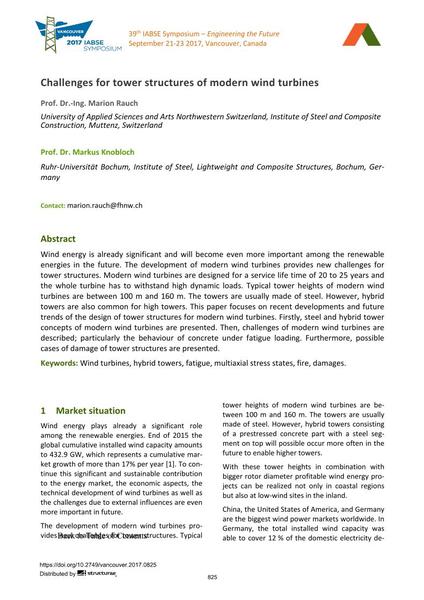Challenges for tower structures of modern wind turbines

|
|
|||||||||||
Détails bibliographiques
| Auteur(s): |
Marion Rauch
(University of Applied Sciences and Arts Northwestern Switzerland, Institute of Steel and Composite Construction, Muttenz, Switzerland)
Markus Knobloch (Ruhr-Universität Bochum, Institute of Steel, Lightweight and Composite Structures, Bochum, Ger- many) |
||||
|---|---|---|---|---|---|
| Médium: | papier de conférence | ||||
| Langue(s): | anglais | ||||
| Conférence: | IABSE Symposium: Engineering the Future, Vancouver, Canada, 21-23 September 2017 | ||||
| Publié dans: | IABSE Symposium Vancouver 2017 | ||||
|
|||||
| Page(s): | 825-832 | ||||
| Nombre total de pages (du PDF): | 8 | ||||
| Année: | 2017 | ||||
| DOI: | 10.2749/vancouver.2017.0825 | ||||
| Abstrait: |
Wind energy is already significant and will become even more important among the renewable energies in the future. The development of modern wind turbines provides new challenges for tower structures. Modern wind turbines are designed for a service life time of 20 to 25 years and the whole turbine has to withstand high dynamic loads. Typical tower heights of modern wind turbines are between 100 m and 160 m. The towers are usually made of steel. However, hybrid towers are also common for high towers. This paper focuses on recent developments and future trends of the design of tower structures for modern wind turbines. Firstly, steel and hybrid tower concepts of modern wind turbines are presented. Then, challenges of modern wind turbines are described; particularly the behaviour of concrete under fatigue loading. Furthermore, possible cases of damage of tower structures are presented. |
||||
| Mots-clé: |
éoliennes tours hybrides
|
||||
